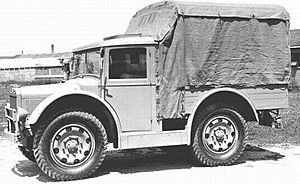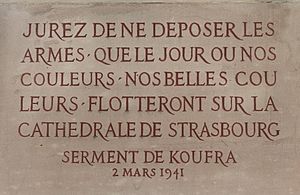Capture of Kufra facts for kids
Quick facts for kids Battle of Kufra |
|||||||
|---|---|---|---|---|---|---|---|
| Part of Operation Compass, during the Second World War | |||||||
 UN map of Libya, Kufra (now Al Kufrah) to the south-east |
|||||||
|
|||||||
| Belligerents | |||||||
| Commanders and leaders | |||||||
|
|||||||
| Strength | |||||||
| 1 FFF Battalion (350 men) 1 LRDG (76 men) 60 trucks |
2 Italian Askari Company (310 men) 1 Auto-Saharan Company (120 men) 20 trucks 4 aircraft |
||||||
| Casualties and losses | |||||||
| 4 killed 21 wounded |
3 killed 4 wounded 282 captured 3 aircraft destroyed |
||||||
The Capture of Kufra was an important event during the Second World War. It was part of the Western Desert Campaign, a series of battles fought in the deserts of North Africa. Kufra is a group of oases (places in the desert with water and plants) located in south-eastern Libya. In 1940, this area was part of Italian Libya, a colony of Italy.
From January 31 to March 1, 1941, Free French forces, with some help from the British Long Range Desert Group, surrounded and attacked Kufra. They eventually forced the Italian and Libyan soldiers defending the area to surrender.
Contents
Kufra: A Desert Stronghold
Kufra is in the Libyan Desert, which is part of the huge Sahara desert. For a long time, it was a key spot for trade and travel for desert people like the Berbers and Senussi. The Senussi even made Kufra their capital at one point.
In 1931, the Kingdom of Italy took control of Kufra. They made it part of their growing colony in North Africa. The Italian base at Kufra included an airfield, a radio station for communication, and a fort in a nearby village called El Tag.
Getting Ready for Battle
After France was defeated in 1940, the French colony of French Equatorial Africa (FEA) decided to support Free France. This was a government-in-exile led by Charles de Gaulle. Chad, which is the northern part of FEA, shares a border with Libya.
De Gaulle ordered the Free French in Chad to attack Italian positions in Libya. Kufra was the main target. The Free French commander in Chad, Lieutenant Colonel Jean Colonna d'Ornano, had about 5,000 riflemen and three groups of camel cavalry.
The Desert Challenge
Attacking Kufra was very difficult. The Free French had very few trucks and needed to travel about 400 kilometers (250 miles) across the desert. Much of this land was covered in sand dunes or soft, powdery soil that was hard for vehicles to cross.
The British Long Range Desert Group (LRDG) offered help. The LRDG was a special unit that knew a lot about navigating the desert. Major Pat Clayton of the LRDG wanted to work with the Free French. His group had 76 men and 26 vehicles.
The Murzuk Raid
The LRDG and Free French first attacked the Italian airfield at Murzuk on January 11, 1941. They surprised the guards and caused a lot of damage. They destroyed three Italian planes and captured some prisoners.
Sadly, d'Ornano was killed during this raid, along with one LRDG soldier. A French officer was wounded but showed great bravery. A separate attack by French camel cavalry failed because their local guides betrayed them.
The Battle for Kufra
Colonel Philippe Leclerc took command after d'Ornano's death. After the success at Murzuk, Leclerc gathered his forces to attack Kufra. His attacking group had about 400 men in sixty trucks. They also had scout cars, personnel carriers, and two 75 mm mountain guns.
Kufra was well-protected. The El Tag fort had two lines of defense with barbed wire, trenches, machine-guns, and anti-aircraft guns. The Italian army had about 280 local infantry soldiers (called Askari) and a special motorized company called the Auto-Saharan Company. This company had about 120 men and well-armed vehicles. They could also get support from the Italian air force.
The Fight at Gebel Sherif
Leclerc asked the LRDG to deal with the Italian Saharan company. The Italians discovered the LRDG's location and sent a mobile group of forty men and vehicles to stop them.
On January 31, Major Clayton and his LRDG patrol were spotted by an Italian plane. The plane guided the Italian Saharan patrol to attack the LRDG. The Italian vehicles had powerful 20 mm cannons, and there were constant air attacks. The LRDG patrol was forced to retreat, losing four trucks. Major Clayton and several others were captured. Trooper Ronald Moore bravely led the remaining survivors to safety after a long walk. The rest of the LRDG went back to Egypt. The Italian commander, 1st Lieutenant Caputo, was killed in the fight, along with two Libyan soldiers.
The Siege of El Tag Fort
Leclerc continued his attack, even though the Italians had found his plans when they captured Major Clayton. On February 16, Leclerc reorganized his forces. Many trucks had broken down, so only about 350 men reached Kufra.
The Italians sent another mobile group from the Saharan company to meet Leclerc's forces. On February 17, Leclerc's troops met the Italian Saharan company north of Kufra. The French lost many trucks to the Italian 20 mm guns. However, they managed to drive off the Italian company. The Kufra fort's defenders did not help the Saharan company.
The French then surrounded the El Tag fort and began a siege. They used their 75 mm gun from about 3,000 meters (1.8 miles) away, which was too far for the fort's defenders to shoot back. They fired about twenty shells a day from different spots to make it seem like they had more guns. They also used 81 mm mortars from closer range to put more pressure on the Italians.
Italian Surrender
The fort was commanded by an inexperienced captain who did not want to keep fighting. Talks for surrender began on February 28. On March 1, 1941, the Italian soldiers at El Tag and the Kufra oasis surrendered to the Free French.
The Italian garrison had lost one officer and two Libyan soldiers killed, with four wounded. The French had four soldiers killed and 21 wounded. The Italian soldiers were allowed to leave. The French forces took control of eight Italian light trucks, six lorries, four 20 mm cannons, and 53 machine-guns.
The Oath of Kufra
After Kufra fell, Leclerc and his troops made a famous promise. They swore they would not stop fighting until the French flag flew over the Cathedral of Strasbourg.
Leclerc said: "Swear not to lay down arms until our colours, our beautiful colours, fly over Strasbourg Cathedral."
This promise was kept on November 23, 1944. On that day, Leclerc and the French 2nd Armoured Division successfully liberated Strasbourg.
|




